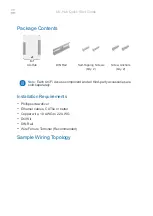
3.3.8 Controlling a 3-Phase Interleaved DC/DC Converter
A popular power topology that makes use of phase-offset between modules is shown in
. This
system uses three PWM modules, with module 1 configured as the master. To work, the phase relationship
between adjacent modules must be F = 120°. This is achieved by setting the slave TBPHS registers 2 and 3 with
values of 1/3 and 2/3 of the period value, respectively. For example, if the period register is loaded with a value
of 600 counts, then TBPHS (slave 2) = 200 and TBPHS (slave 3) = 400. Both slave modules are synchronized to
the master 1 module.
This concept can be extended to four or more phases, by setting the TBPHS values appropriately. The following
formula gives the TBPHS values for N phases:
TBPHS(N,M) = (TBPRD/N) x (—1)
Where:
N = number of phases
M = PWM module number
For example, for the 3-phase case (N=3), TBPRD = 600,
TBPHS(3,2) = (600/3) x (2-1) = 200 (that is, Phase value for Slave module 2)
TBPHS(3,3) = 400 (Phase value for Slave module 3)
shows the waveforms for the configuration in
CTR=zero
CTR=CMPB
X
En
SyncOut
Phase reg
Ext SyncIn
(optional)
EPWM1A
EPWM1B
SyncOut
Phase reg
CTR=CMPB
CTR=zero
X
En
EPWM2B
EPWM2A
Slave
Master
EPWM1A
SyncIn
SyncIn
EPWM1B
CTR=zero
CTR=CMPB
SyncOut
X
EPWM3B
Phase reg
Slave
En
SyncIn
EPWM3A
1
2
3
V
IN
EPWM2B
EPWM2A
EPWM3A
EPWM3B
V
OUT
Φ
=0
°
Φ
=120
°
Φ
=120
°
Φ
=240
°
Figure 3-64. Control of a 3-Phase Interleaved DC/DC Converter
Enhanced Pulse Width Modulator (ePWM) Module
318
TMS320x2806x Microcontrollers
SPRUH18I – JANUARY 2011 – REVISED JUNE 2022
Copyright © 2022 Texas Instruments Incorporated
Summary of Contents for TMS320 2806 Series
Page 2: ......















































